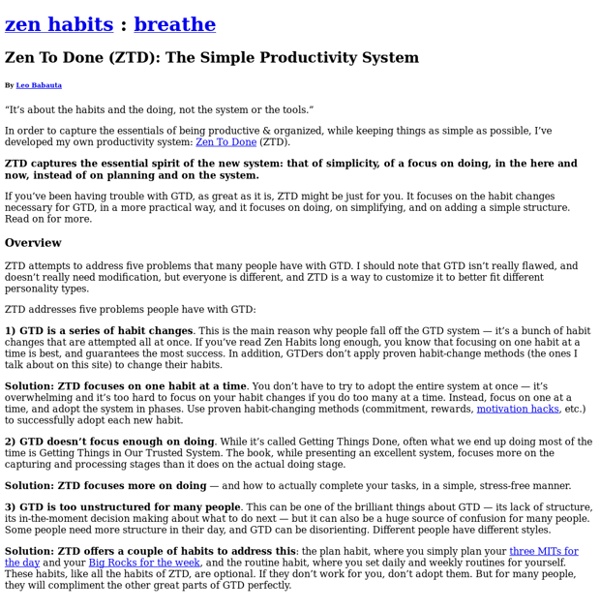Zen To Done (ZTD): The Ultimate Simple Productivity System

Forget To-Do Lists. Focus on This Instead.
Source: PicJumbo. Do you make to-do lists? If so, stop. They don’t work. According to Janet Choi and Walter Chen, 41% of your to-do list items don’t get done and those that do, don’t correlate with what you set out to do. [1] I can relate. How does that happen? I would feel disappointed because I had not made headway with my goals and I would lose momentum. That is until I read James Altucher’s new book, The Choose Yourself Guide to Wealth, and was introduced to having themes instead. Let me explain. The Problem with To-Do Lists “Abundance only comes when you are moving along your themes – when you are truly enhancing the lives of the people around you”– James Altucher. The problem with to-do lists is that they are very goal orientated and come with a number of disadvantages. For example… They can cause anxiety. They don’t highlight importance. We don’t know what should be on it. They can cause disappointment. The solution? Make a Themes List Conclusion Create a list of themes for your life.
Weekly Planning — the spark notebook
Happy Friday! I hope you are having a lovely day today. Spark Notebooks are starting to arrive all over the world and it is so wonderful to hear all the excitement. When you get yours, be sure to let me know! As people are getting their notebooks though, I realized I messed up. Why are there no instructions? So, I am working on a guide, and we will probably print it on paper and distribute it with future versions of the notebook. Today, I put together some quick notes on how to do a weekly planning session. Every week I start my week with a planning session. You can do your planning Sunday night, or first thing Monday morning (that is when I do my planning session) or even on Fridays if that works better for you. Below is an agenda for your weekly planning session. 1) Each week start your planning with the Weekly Goals page. 2) Look back on your previous week and see what you accomplished and what was left over. 3) Then think about the good things that happened last week.
Soundcloud1Learn more about this providerWIDGET::local::assignmentsUsed by audio-platform SoundCloud to implement, measure and improve their embedded content/service on the website - The collection of data also includes visitors’ interaction with embedded content/service. This can be used for statistics or marketing purposes. Expiry: PersistentType: HTMLYouTube32Learn more about this provider#-#PendingExpiry: SessionType: HTMLiU5q-!
The Not-To-Do List: 9 Habits to Stop Now
This is how the world felt before Crackberries. (LeoLuigi)“Not-to-do” lists are often more effective than to-do lists for upgrading performance. The reason is simple: what you don’t do determines what you can do. Here are nine stressful and common habits that entrepreneurs and office workers should strive to eliminate. 1. 2. 3. 4. 6. 7. 8. It’s hip to focus on getting things done, but it’s only possible once we remove the constant static and distraction. What other no-no’s would you add to the list?
Do vs. Done Lists: Jot Down Your Small Wins to Amplify Success
If you’re reading the Evernote Blog, chances are you’re someone who loves to get things done. To move the needle. But have you ever had the suspicion that the way you’re approaching your to-do list and overall task planning is hindering your effectiveness? Perhaps your processes are increasing stress or anxiety (known disruptors to problem-solving) and clouding your creative thought. The power of progress It’s interesting to note that according to research, having a sense of making progress with work that matters to us is the most influential factor in maximizing long-term creative output, positive emotions, and motivation. A done list is a log of the tasks you’ve completed. Success leaves clues Renowned entrepreneur and venture capitalist Marc Andreessen, co-founder of Netscape, cheekily calls it the “Anti To-Do List.” All of these systems refer to the process of reflecting and writing down what you’ve done. When we reflect on progress, we practically metabolize it.
Getting Started with GTD Templates
It’s 4:45 p.m. on Wednesday afternoon, and you have one question on your mind: what should I be doing right now? You’re busy getting things done, but the notification count on your email inbox is climbing by the minute. You really should get back to Tom on…what was it again? Now the phone is ringing—it’s your kid’s teacher, informing you that your daughter’s grades are low and she needs some extra attention. You have an emergency meeting at 5:00, which kills your plan to finalize the agenda for tomorrow’s offsite. Welcome to the era of information abundance, which has created in many of us a scarcity of attention. David Allen’s best-selling book Getting Things Done* (known affectionately by fans as GTD) proposes a simple 5-step approach to managing the complexity of modern work. Here are the steps to stress-free productivity that GTD recommends: The best introduction to what these five steps look like in practice is the Project List Mindsweep. How to use Evernote templates » Don’t judge.
Related:



